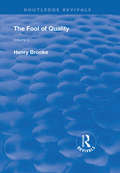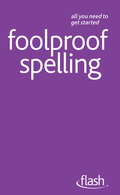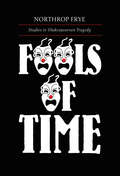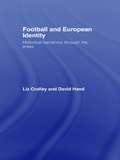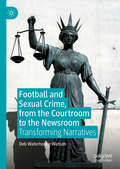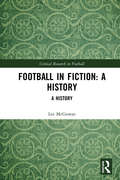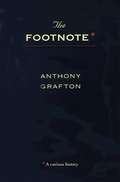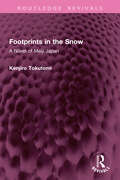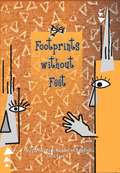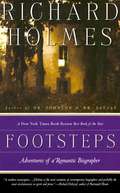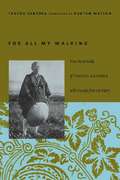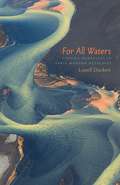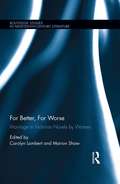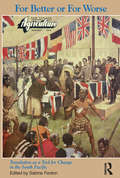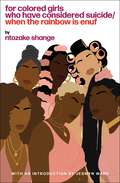- Table View
- List View
The Fool of Quality: Volume 5 (Routledge Revivals)
by Henry BrookeFirst published in 1906, The Fool of Quality; a picaresque and sentimental novel by the Irish writer Henry Brooke, is the only one of his works which has enjoyed any great reputation. The somewhat shapeless plot is an account of the doings of young Harry Clinton, who, rejected by his decadent and aristocratic father, is educated on enlightened principles by his philanthropic uncle. Thus equipped to fight the evils of the world the innocent yet wise hero does his best to better the lot of the unfortunate Hammel Clement and his family, and other deserving cases, in the intervals between the author's frequent philosophical digressions and commentaries on the action. This book is the fifth of five volumes.
Foolproof Spelling: Flash
by Elspeth SummersThe books in this bite-sized new series contain no complicated techniques or tricky materials, making them ideal for the busy, the time-pressured or the merely curious. Foolproof Spelling is a short, simple and to-the-point guide to learning the basic principles of correct spelling in a few short steps. Whether to brush up on writing skills, do better in exams or simply to feel more confident, in just 96 pages you will discover how to master the essential rules and feel more in control of their writing.
Foolproof Spelling: Flash
by Elspeth SummersThe books in this bite-sized new series contain no complicated techniques or tricky materials, making them ideal for the busy, the time-pressured or the merely curious. Foolproof Spelling is a short, simple and to-the-point guide to learning the basic principles of correct spelling in a few short steps. Whether to brush up on writing skills, do better in exams or simply to feel more confident, in just 96 pages you will discover how to master the essential rules and feel more in control of their writing.
Fools of Time: Studies in Shakespearean Tragedy
by Northrop FryeIn the Alexander Lectures for 1965-66 at the University of Toronto, Dr. Frye describes the basis of the tragic vision as "being in time," in which death as "the essential event that gives shape and form to life ... defines the individual, and marks him off from the continuity of life that flows indefinitely between the past and the future." In Dr. Frye's view, three general types can be distinguished in Shakespearean tragedy, the tragedy of order, the tragedy of passion, and the tragedy of isolation, in all of which a pattern of "being in time" shapes the action. In the first type, of which Julius Caesar, Macbeth, and Hamlet are examples, a strong ruler is killed, replaced by a rebel-figure, and avenged by a nemesis-figure; in the second, represented by Romeo and Juliet, Anthony and Cleopatra, and Troilus and Cressida, authority is split and the hero is destroyed by a conflict between social and personal loyalties; and in the third, Othello, King Lear, and Timon of Athens, the central figure is cut off from his world, largely as a result of his failure to comprehend the dynamics of that world. What all these plays show us, Dr. Frye maintains, is "the impact of heroic energy on the human situation" with the result that the "heroic is normally destroyed ... and the human situation goes on surviving." Fools of Time will be welcomed not only by many scholars who are familiar with Dr. Frye's keen critical insight but also by undergraduates, graduates, high-school and university teachers who have long valued his work as a means toward a firmer grasp and deeper understanding of English literature.
Fools of Time: Studies in Shakespearean Tragedy
by Northrop FryeIn Dr. Frye's view, 3 general types can be distinguished in Shakespearean tragedy: the tragedy of order, the tragedy of passion, and the tragedy of isolation, in all of which a pattern of "being in time" shapes the action.
Fools Rush In: Steve Case, Jerry Levin, and the Unmaking of AOL Time Warner
by Nina MunkA carefully explained business debacle.
Fool's Talk: Recovering the Art of Christian Persuasion
by Os GuinnessChristianity TodayOne of Desiring God's Top 15 Books of 2015Hearts Minds Bookstore's Best Books of 2015, Social Criticism and Cultural Engagement
Football and European Identity: Historical Narratives Through the Press
by Liz Crolley David HandShifting European identities, cultural loyalties and divisions are often expressed more directly through attitudes to 'the people's game' game than in any other arena. This book examines European football journalism from throughout the last century to present a unique cross-cultural analysis of changing European national and regional identities. Building on detailed research into original language sources from across Western Europe, from the early 20th century to the present day, Football and European Identity traces this fascinating evolution. The resulting cross-cultural analysis of national identity in Europe provides the basis for a unique study of the interplay between football, society, politics and the print media, in three parts: Part 1: Old Europe national identity in the football writing of England, France, Germany, Italy and Spain Part 2: Nations within a State examines the status of Corsican, Catalonian and Basque identities Part 3: New (Football) Worlds explores the response of Europe’s presses to the emergence of Africa, South East Asia and the USA as major forces in world football
Football and Sexual Crime, from the Courtroom to the Newsroom: Transforming Narratives
by Deb Waterhouse-WatsonThis book interrogates the process of court reporting on rape and other sexual crime cases involving Australian footballers. At the intersection of sport, gender, media and the law, it uncovers the story behind rape myths and stereotypes in media. This book analyses newspaper reporting alongside transcripts of the trials they represent and interviews with the journalists themselves. Waterhouse-Watson’s work maps structural factors within newsrooms, and the complex relationship between the judiciary and media, that affect the practice of court reporting. This book approaches key journalism concepts like objectivity and balance critically, illustrating the layers of mediation that surround a complainant’s testimony; the way sport shapes the meaning of courtroom and media narratives in these cases; and the tension between racism and sexism when race is thematised or otherwise highlighted. Ultimately, the book proposes an ethics of court reporting that protects individual complainants, as well as advancing public understandings of the crime.
Football in Fiction: A History (Critical Research in Football)
by Lee McGowanFootball in Fiction represents the most comprehensive historical mapping and analysis of novels related to association football (soccer). It offers a theoretically informed field guide, a scholarly cartography of football fiction’s uncertain – and until now – only partially explored terrain. Combining an extensive search for texts with up-to-date academic research, journals, surveys, catalogues, and reviews the book demonstrates a topographic perspective of the field – one that captures and establishes its breadth, depth, and distinctive identity. The book uses and adapts two distinct reading models of abstraction, in conjunction with closer textual analyses. Together they assist in realising a set of demonstrable conventions, outline a taxonomy of fictive types, establish the genre’s current state of play, and advance the football novel as a form with its own literary history and traditions. This book is a valuable resource for those studying and researching in the areas of the social and cultural aspects of football, sports fiction, sports writing, creative writing, and literary and genre studies. Furthermore, related industry professionals will find this a fascinating read, particularly football writers, fans of the sport, and those interested in sports history and cultural phenomena.
The Footnote: A Curious History
by Anthony GraftonThe weapon of pedants, the scourge of undergraduates, the bête noire of the âeoenewâe liberated scholar: the lowly footnote, long the refuge of the minor and the marginal, emerges in this book as a singular resource, with a surprising history that says volumes about the evolution of modern scholarship. In Anthony Graftonâe(tm)s engrossing account, footnotes to history give way to footnotes as history, recounting in their subtle way the curious story of the progress of knowledge in written form. Grafton treats the development of the footnoteâe"the one form of proof normally supplied by historians in support of their assertionsâe"as writers on science have long treated the development of laboratory equipment, statistical arguments, and reports on experiments: as a complex story, rich in human interest, that sheds light on the status of history as art, as science, and as an institution. The book starts in the Berlin of the brilliant nineteenth-century historian Leopold von Ranke, who is often credited with inventing documented history in its modern form. Casting back to antiquity and forward to the twentieth century, Graftonâe(tm)s investigation exposes Rankeâe(tm)s position as a far more ambiguous one and offers us a rich vision of the true origins and gradual triumph of the footnote. Among the protagonists of this story are Athanasius Kircher, who built numerous documents into his spectacularly speculative treatises on ancient Egypt and China; Pierre Bayle, who made the footnote a powerful tool in philosophical and historical polemics; and Edward Gibbon, who transformed it into a high form of literary artistry. Proceeding with the spirit of an intellectual mystery and peppered with intriguing and revealing remarks by those who âeoemadeâe this history, The Footnote brings what is so often relegated to afterthought and marginalia to its rightful place in the center of the literary life of the mind.
Footprints in the Snow: A Novel of Meiji Japan (Routledge Revivals)
by Kenjiro TokutomiFirst published in 1901 and this English translation in 1970, Footprints in the Snow is one of the most popular novels in modern Japan. It is the story of the struggle of a penniless Japanese boy Shintaro Kikuchi, for education and emancipation. Determined to rebuild the family fortunes after his father's bankruptcy, Shintaro runs away from home in a remote corner of Kyushu, in the hope of making his way in the world. Robbed by pickpockets, he nearly dies of hunger and exhaustion, then after slaving for months as a money-lender’s boy eventually succeeds in reaching a Christian College in Kyoto. A brilliant student, he accepts Christianity enthusiastically, but is also repelled by the arrogance of the Western missionary teachers towards a Japanese colleague that he walks out in protest. At last, four years after leaving home, Shintaro arrives in Tokyo. Yet even in the city of his dreams his life is far from peaceful- Shintaro has to struggle to keep himself at University, to pursue his career as a writer and journalist and in order to marry the girl he loves.The original Japanese title of Footprints in the Snow is Omoide no Ki. Kenjiro Tokutomi ‘s novel is still read in Japan today and more than any other novel conveys what it felt like to be young in the days of Japan’s great transformation from feudal to modern state. This is an interesting read for students of Japanese literature, Asian literature, and literature in general
Footprints Without Feet class 10 - NCERT
by National Council of Educational Research and TrainingThis book prescribed by central board of secondary education, India for the students of class 10th subject Supplementary English This accessible version of the book doesn't leave any part of the book. The book is handy companion of the school going students.
Footprints Without Feet class 10 - NCERT - 23
by National Council of Educational Research and Training"Footprints Without Feet" is a textbook for Class X by NCERT that offers a diverse collection of ten fascinating stories from various authors. These stories span multiple genres and touch upon intriguing themes, such as science fiction, human relationships, societal norms, and the mysteries of life and existence. From the tale of a man who becomes invisible in H.G. Wells' "Footprints Without Feet" to the story of a robot who begins to understand human emotions in "The Fun They Had" by Isaac Asimov, the book captivates its readers with unique perspectives on the human condition. Other stories touch upon issues of identity, moral dilemmas, and the effects of advanced technology on society. Through its rich narrative tapestry, the book encourages students to ponder on complex questions, enhancing their analytical and interpretative skills while providing a delightful reading experience.
Footprints without Feet Supplementary Reader class 10 - JCERT
by Jharkhand Council of Educational Research and Training Ranchi“Footprints Without Feet” is a supplementary reader for Class 10 English. It consists of multiple stories that aim to develop students' reading and critical thinking skills. The stories, which range from personal relationships to adventures, reflect themes that resonate with young learners. One of the stories, “Footprints Without Feet,” is about a scientist who discovers how to make himself invisible and the consequences of his actions. The book encourages students to reflect on broader societal and ethical issues through thought-provoking questions, and its diverse content ensures an engaging learning experience.
Footsteps: Adventures of a Romantic Biographer
by Richard HolmesIn this gripping book, Holmes takes us from France's Massif Central, where he followed the route taken by Robert Louis Stevenson and a sweet-natured donkey, to Mary Wollstonecraft's Revolutionary Paris, to the Italian villages where Percy Shelly tried to cast off the structures of English morality and marriage.
For All My Walking: Free-Verse Haiku of Taneda Santoka
by Taneda Santoka Burton WatsonIn April 1926, the Japanese poet Taneda Santoka (1882--1940) set off on the first of many walking trips, journeys in which he tramped thousands of miles through the Japanese countryside. These journeys were part of his religious training as a Buddhist monk as well as literary inspiration for his memorable and often painfully moving poems. The works he wrote during this time comprise a record of his quest for spiritual enlightenment. Although Santoka was master of conventional-style haiku, which he wrote in his youth, the vast majority of his works, and those for which he is most admired, are in free-verse form. He also left a number of diaries in which he frequently recorded the circumstances that had led to the composition of a particular poem or group of poems. In For All My Walking,master translator Burton Watson makes Santoka's life story and literary journeys available to English-speaking readers and students of haiku and Zen Buddhism. He allows us to meet Santoka directly, not by withholding his own opinions but by leaving room for us to form our own. Watson's translations bring across not only the poetry but also the emotional force at the core of the poems. This volume includes 245 of Santoka's poems and of excerpts from his prose diary, along with a chronology of his life and a compelling introduction that provides historical and biographical context to Taneda Santoka's work.
For All My Walking: Free-Verse Haiku of Taneda Santoka (Modern Asian Literature Series)
by Santoka TanedaIn April 1926, the Japanese poet Taneda Santoka (1882–1940) set off on the first of many walking trips, journeys in which he tramped thousands of miles through the Japanese countryside. These journeys were part of his religious training as a Buddhist monk as well as literary inspiration for his memorable and often painfully moving poems. The works he wrote during this time comprise a record of his quest for spiritual enlightenment.Although Santoka was master of conventional-style haiku, which he wrote in his youth, the vast majority of his works, and those for which he is most admired, are in free-verse form. He also left a number of diaries in which he frequently recorded the circumstances that had led to the composition of a particular poem or group of poems. In For All My Walking, master translator Burton Watson makes Santoka's life story and literary journeys available to English-speaking readers and students of haiku and Zen Buddhism. He allows us to meet Santoka directly, not by withholding his own opinions but by leaving room for us to form our own. Watson's translations bring across not only the poetry but also the emotional force at the core of the poems. This volume includes 245 of Santoka's poems and of excerpts from his prose diary, along with a chronology of his life and a compelling introduction that provides historical and biographical context to Taneda Santoka's work.
For All Waters: Finding Ourselves in Early Modern Wetscapes
by Lowell DuckertRecent years have witnessed a surge in early modern ecostudies, many devoted to Shakespearean drama. Yet in this burgeoning discipline, travel writing appears moored in historicization, inorganic subjects are far less prevalent than organic ones, and freshwater sites are hardly visited. For All Waters explores these uncharted wetscapes. Lowell Duckert shows that when playwrights and travel writers such as Sir Walter Raleigh physically interacted with rivers, glaciers, monsoons, and swamps, they composed &“hydrographies,&” or bodily and textual assemblages of human and nonhuman things that dissolved notions of human autonomy and its singular narrativity. With a playful, punning touch woven deftly into its theoretical rigor, For All Waters disputes fantasies of ecological solitude that would keep our selves high and dry and that would try to sustain a political ecology excluding water and the poor. The lives of both humans and waterscapes can be improved simultaneously through direct engagement with wetness. For All Waters concludes by investigating waterscapes in peril today—West Virginia&’s chemical rivers and Iceland&’s vanishing glaciers—and outlining what we can learn from early moderns&’ eco-ontological lessons. By taking their soggy and storied matters to heart, and arriving at a greater realization of our shared wetness, we can conceive new directions to take within the hydropolitical crises afflicting us today.
For Attribution —Developing Data Attribution and Citation Practices and Standards: Summary of an International Workshop
by Paul F. Uhlir RapporteurThe growth of electronic publishing of literature has created new challenges, such as the need for mechanisms for citing online references in ways that can assure discoverability and retrieval for many years into the future. The growth in online datasets presents related, yet more complex challenges. It depends upon the ability to reliably identify, locate, access, interpret and verify the version, integrity, and provenance of digital datasets. <P> Data citation standards and good practices can form the basis for increased incentives, recognition, and rewards for scientific data activities that in many cases are currently lacking in many fields of research. The rapidly-expanding universe of online digital data holds the promise of allowing peer-examination and review of conclusions or analysis based on experimental or observational data, the integration of data into new forms of scholarly publishing, and the ability for subsequent users to make new and unforeseen uses and analyses of the same data - either in isolation, or in combination with other datasets.
For Better, For Worse: Marriage in Victorian Novels by Women (Routledge Studies in Nineteenth Century Literature)
by Carolyn Lambert Marion ShawThis interdisciplinary volume explores the fictional portrayal of marriage by women novelists between 1800 and 1900. It investigates the ways in which these novelists used the cultural form of the novel to engage with and contribute to the wider debates of the period around the fundamental cultural and social building block of marriage. The collection provides an important contribution to the emerging scholarly interest in nineteenth-century marriage, gender studies, and domesticity, opening up new possibilities for uncovering submerged, marginalized, and alternative stories in Victorian literature. An initial chapter outlines the public discourses around marriage in the nineteenth century, the legal reforms that were achieved as a result of public pressure, and the ways in which these laws and economic concerns impacted on the marital relationship. It beds the collection down in current critical thinking and draws on life writing, journalism, and conduct books to widen our understanding of how women responded to the ideological and cultural construct of marriage. Further chapters examine a range of texts by lesser-known writers as well as canonical authors structured around a timeline of the major legal reforms that impacted on marriage. This structure provides a clear framework for the collection, locating it firmly within contemporary debate and foregrounding female voices. An afterword reflects back on the topic of marriage in the nineteenth- century and considers how the activism of the period influenced and shaped reform post-1900. This volume will make an important contribution to scholarship on Victorian Literature, Gender Studies, Cultural Studies, and the Nineteenth Century.
For Better or for Worse: Translation as a Tool for Change in the South Pacific
by Sabine FentonThe essays in this book explore the vital role translation has played in defining, changing and redefining linguistic, cultural, ethnic and political identities in several nations of the South Pacific. While in other parts of the world postcolonial scholars have scrutinized the role and history of translation and exposed its close relationship with the colonizers, this has not yet happened in the specific region covered in this collection. In translation studies the Pacific region is terra incognita. The writers of this volume of essays reveal that in the Pacific, as in all other once colonized parts of the world, colonialism and translation went hand in hand. The unsettling power of translation is described as it effected change for better or for worse. While the Pacific Islanders' encounter with the Europeans has previously been described as having a 'Fatal Impact', the authors of these essays are further able to demonstrate that the Pacific Islanders were not only victims but also played an active role in the cross-cultural events they were party to and in shaping their own destinies. Examples of the role of translation in effecting change - for better or for worse - abound in the history of the nations of the Pacific. These stories are told here in order to bring this region into the mainstream scholarly attention of postcolonial and translation studies.
For colored girls who have considered suicide/When the rainbow is enuf
by Ntozake ShangeNtozake Shange&’s classic, award-winning play encompassing the wide-ranging experiences of Black women, now with introductions by two-time National Book Award winner Jesmyn Ward and Broadway director Camille A. Brown.From its inception in California in 1974 to its Broadway revival in 2022, the Obie Award–winning for colored girls who have considered suicide/when the rainbow is enuf has excited, inspired, and transformed audiences all over the country for nearly fifty years. Passionate and fearless, Shange&’s words reveal what it meant to be a woman of color in the 20th century. First published in 1975, when it was praised by The New Yorker for &“encompassing…every feeling and experience a woman has ever had,&” for colored girls who have considered suicide/when the rainbow is enuf will be read and performed for generations to come. Now with new introductions by Jesmyn Ward and Broadway director Camille A. Brown, and one poem not included in the original, here is the complete text of a groundbreaking dramatic prose poem that resonates with unusual beauty in its fierce message to the world.
For Common Things: Irony, Trust and Commitment in America Today
by Jedediah Purdy"This is, perhaps, the work of a love letter... Such a letter brings something delicate and intimate into the light of shared vision. This disclosure is hazardous and frightening, but it is necessary because the kind of love that moves between people cannot survive in solitude. It must be made common if it is to live at all. Love letters, then, require the courage to stake oneself on an expression of hope that may very well come to nothing. They also indicate a perception of importance, a sense that some possibilities, however unlikely, are so important that not acknowledging them would be an act of terrible neglect."
